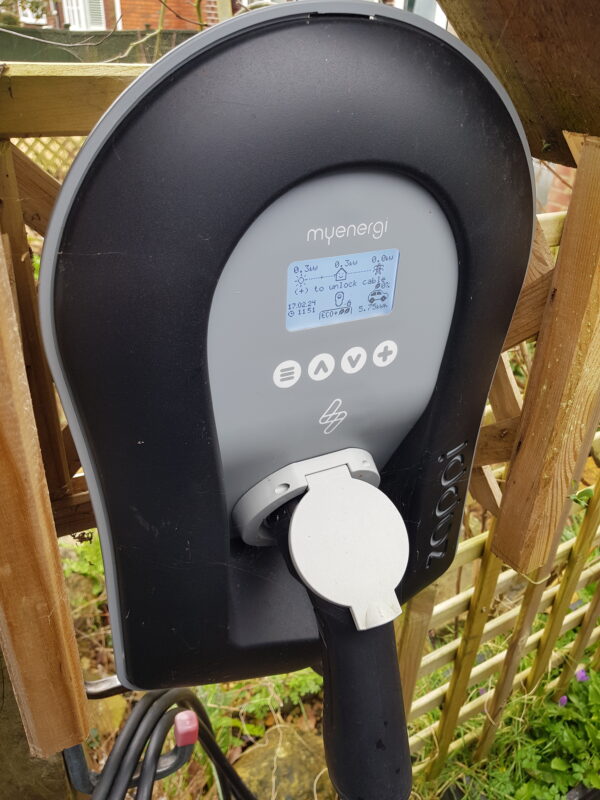So you have solar panels on your roof and you’re thinking of buying an electric vehicle (ev), can you charge your ev from solar?
Well the short answer is yes, but with a few caveats.
When you buy your first Electric Vehicle (EV) or Plug in Hybrid Electric Vehicle (PHEV), it will probably come with a so called ‘granny charger’ that looks something like the one below, as the base level of charging capability. A ‘granny charger’ is able to charge from a standard UK 13A electrical socket, and is named as such because you might be visiting your granny and need to charge your car. There is a bit of a problem with this as UK 13A sockets aren’t rated for continuous supply at maximum current. So you will find the plug gets warm, and, if the socket has a slight loose connection through wear and age there is a potential fire risk. You may also need to use an extension lead to reach the car. If the extension lead is left coiled, or not rated for the full 13A, you again may experience the plug and cable heating if charging for a long period.
So what’s the next cheapest option?
Well you could install a dedicated relatively low cost EV 13A socket like the one shown below. This will have its own dedicated supply and is designed for vehicle charging. It has no intelligence and is really a false economy in the long term as you can’t take advantage of dedicated EV tariffs and intelligent control.
In order to charge from solar here you would need to plug in when the sun is bright and assume that you’ll have excess solar. It may still be possible to access lower night time charging rates though you would need to use your car’s charge setting timer, or wait up late. Typically the rates aren’t as good as using a dedicated intelligent charger.
Granny Charger
The charger shown is the ‘granny charger’ supplied with our Mitsubishi Outlander PHEV. It allows the vehicle to charge from a 13A socket.
The EV socket shown is the simplest form of EV charger and is designed to run at 13A continuously. However it has no intelligence and couldn’t be classified as an EV charger under current legislation as it lacks the intelligent connectivity required to balance the grid through two way communication with your electricity provider. Though low cost to install it’s really a false economy in the long run as it doesn’t allow you to charge by solar diversion or intelligent tariff charging.
The installation shown was a ‘make shift’ one using a cable previously used for our garage supply.
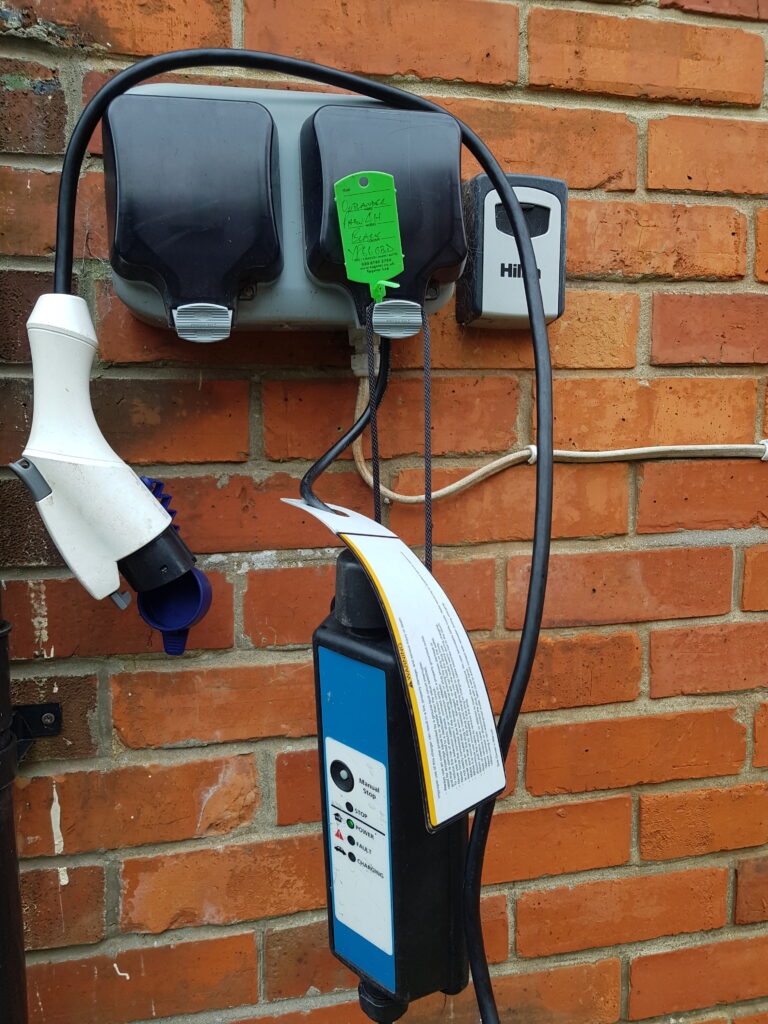
So what’s a better solution to charge my EV from solar?
I did use the low cost EV charging socket for a year when we first purchased our Mitsubishi Outlander PHEV. However we wanted to take advantage of excess solar that during the summer was pouring back into the grid. We also wanted to take advantage of lower cost night time ‘Intelligent’ charging rates which could be as low as 7.5p/kWh .
After quite a lot of research I decided the MyEnergi Zappi charger was my preferred choice. I am a big fan of the YouTube channel ‘Fully Charged Show’, a must for anyone considering buying an EV, and MyEnergi had featured. I liked that they were an innovative British company manufacturing in the UK. They were also one of the first to feature solar diversion to charge your car which seemed to fit my criteria.
In my early career I trained as an electrician and worked as electrical and electronics design engineer, so I was quite keen to undertake the installation myself. I wanted to understand the process, and consequently give first hand advice to Chippenham residents through Zero Chippenham. But don’t worry, Zero Chippenham work closely with Beazer Electrical in Corsham for our Community Solar scheme, and they will be happy to install EV charging for you. It’s also possible your electricity supplier such as Octopus or Good Energy can install EV charging. I found that Octopus have a fairly rigid approach to EV charger installations and anything out of the ordinary results in a ‘computer says x’ style answer. But it may work for your situation and I use Octopus as an electricity supplier.
It’s important to note that it doesn’t matter who installs your charger to switch to an EV tariff. For example I use Intelligent Octopus and the criteria is that your vehicle or charger is on their supported list. Your charger doesn’t need to be installed by Octopus to switch to their EV tariff.
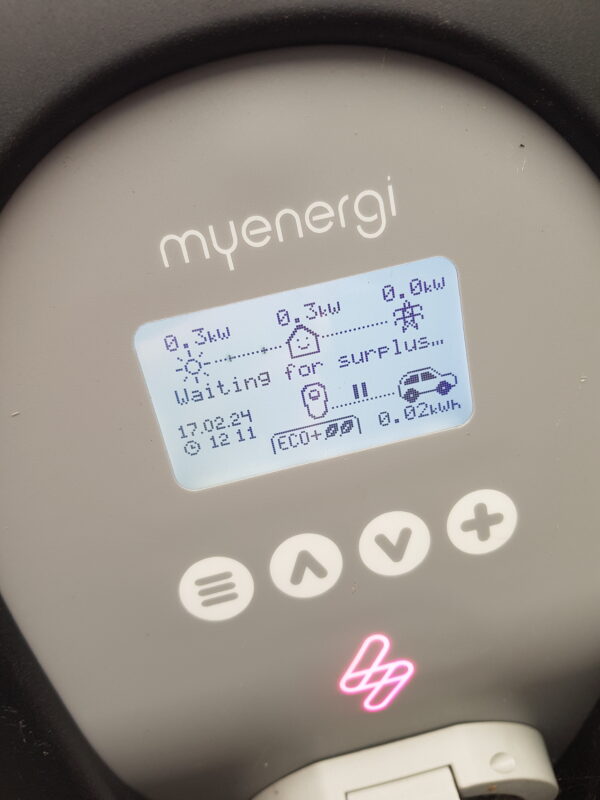
MyEnergi Zappi installation
The Zappi installation was straightforward enough. It requires its own 32A circuit on your electrical consumer unit, and the physical connection could be made using EV cable, which contain both the supply cables for charging, and a set of twisted pair shielded cables for the Current Transformer(s) (CTs).
It comes with either a white or black clip on cover. As it sits outside in my case the cable connection needed to be water tight.
The other choice when ordering is to choose either a ‘tethered’ or ‘untethered’ connection. A tethered connection has a lead and plug supplied. Untethered requires you to purchase your own cable. I chose the untethered option as my Outlander PHEV has a slightly older Type 1 connector port, whereas more modern EVs have a type 2. This meant if I change the car or have a visitor all that needs to change is the cable, not the whole charger.
What are Current Transformer(s)?
Current Transformers (CTs) are a small device that clips around an electrical AC cable. The alternating field induces a current in the CT allowing it to measure the size of the current passing through the cable in Amperes (Amps), and also the direction of flow of the current. For most situations the direction of flow is from the grid towards your house. However, if you have solar panels and the sun is shining, once you have supplied all your other house hold loads (fridge, TV etc), any excess will flow out to the grid. It’s this excess solar electricity we want to charge our car with.
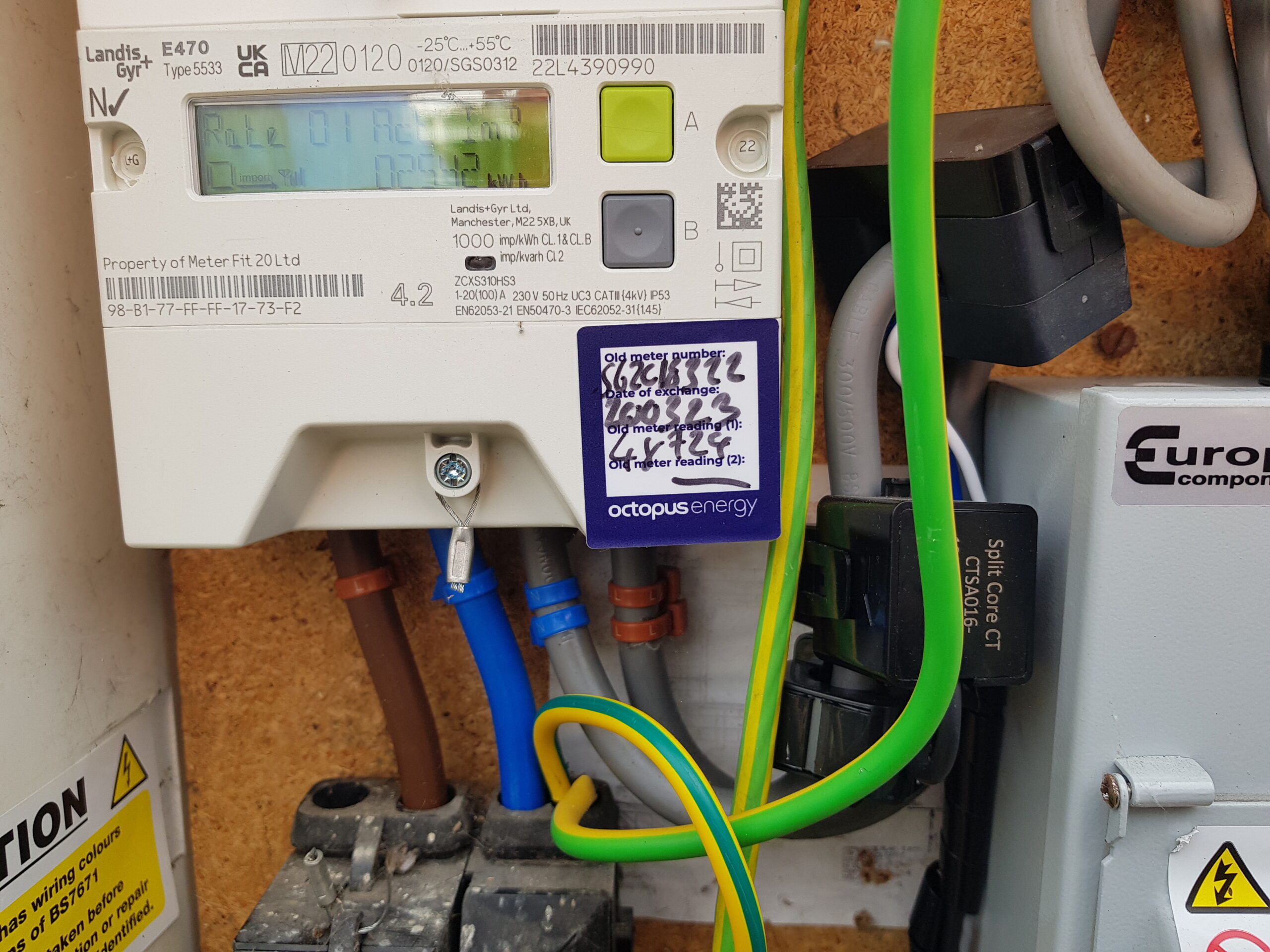
Current Transformers
One for the Zappi, One for my Enphase Solar, One for my Alpha Smile B3 plus House Battery
Necessary Paperwork
Once installation is complete your installer will inform the Distribution Network Operator (DNO) that you have an EV charger installed. In my case this was an online form submission to Scottish and Southern. This helps the network operator model and understand the rapidly changing grid.
How does the Zappi know when you’re generating excess Solar?
A standard Zappi installation requires one CT clipped around your household supply cable immediately after your meter. This will allow the Zappi to detect when you’re exporting electricity to the grid.
The Zappi has three charging modes. Fast, Eco, and Eco+. I usually leave the charger in Eco+ mode. This means when there is excess solar the car will charge if plugged in, and at night Intelligent Octopus charges my car at a low 7.5p/kWh rate.
There is a slight ‘gotcha’. Under EV charging regulations you need to be exporting at least 1.4kW of excess solar to start charging. I’ve found that this limits solar charging to the summer months. If excess solar drops below 1.4kW, as it can do if clouds pass over or you switch the kettle on, you can set the Zappi to import some of the charge from the grid based on a variable percentage as to ‘how green you want to be’ vs ‘your desire to charge the car’. But given the daytime charge rate is 28p/kWh I tend to have it simply pause charging until the kettle goes off or the cloud passes.
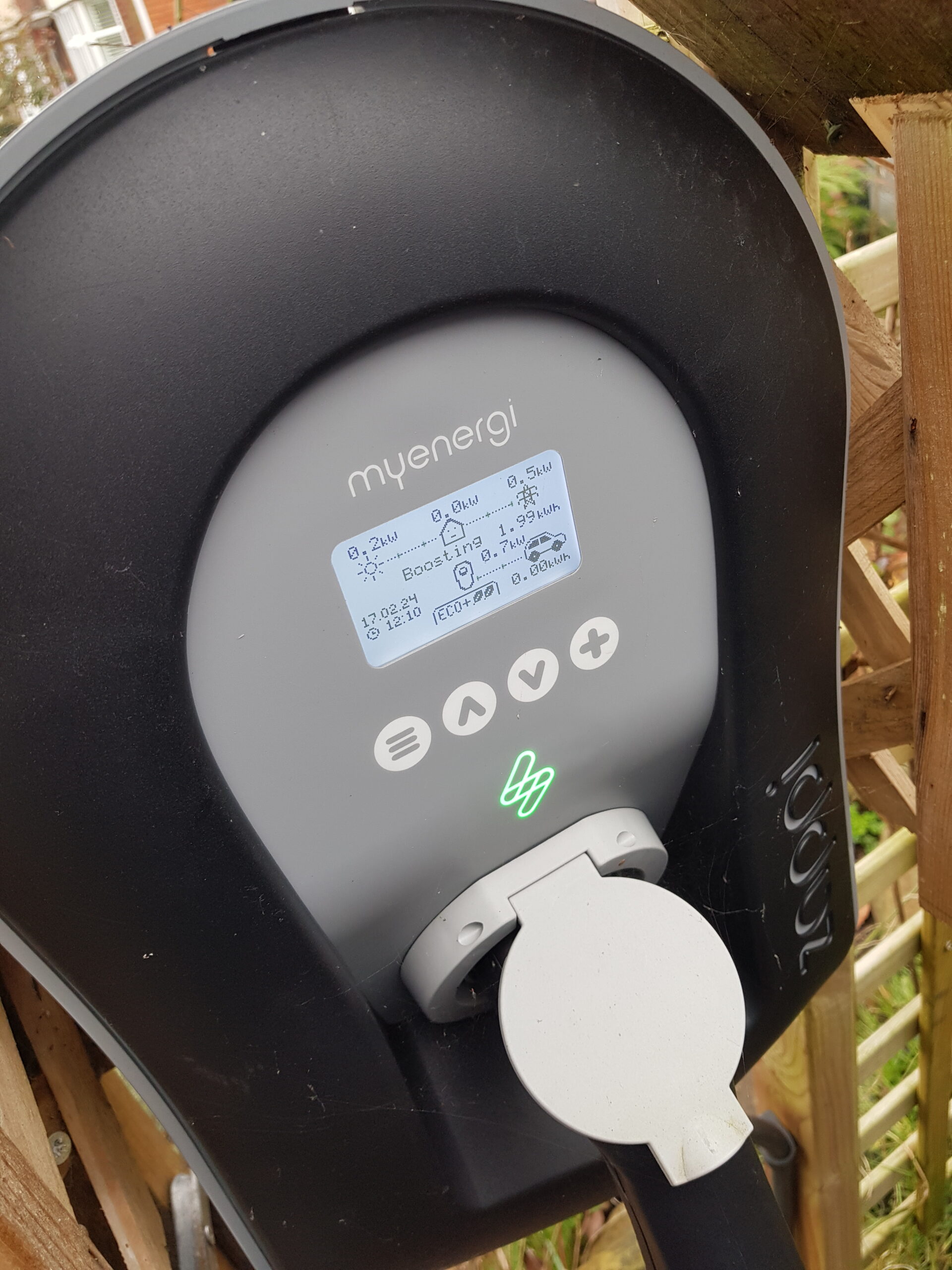
Zappi in Fast Charge mode
The led colours change depending what’s happening
To work out of the box the Zappi only requires one current transformer for solar charging. However as my solar and my later addition of a house battery are manufactured by different companies, I have two additional CTs wired to the Zappi. One from Solar generation, and one from my house battery. These introduce additional icons on the app and allow a greater degree of control. For example I don’t want the Zappi to charge my car by discharging my house battery. In practice they all play together nicely and I don’t think about any of this unless i’m writing up a case study!
What are Smart Tariffs?
To make the most of your Zappi charger you’ll need a Smart meter installed. My electricity provider is Octopus Energy and i signed up to the Intelligent Octopus Go tariff giving me 6 hours of charging at night at 7.5p/kWh. The Zappi is on the Octopus list of compatible chargers. This is important as it allows Octopus to control when charging starts remotely based on the grid status. You set what time in the morning you want your car to be ready and how much charge it needs, Octopus controls the rest.
If you choose a different make of charger and neither your charger or EV are on the list you can still access nighttime charging rates, but they tend to be for a shorter period at a slightly higher rate.
The advantage for me is I also charge my house battery at night and have a ‘Kasa’ programmable extension lead to charge e-bike batteries at night.
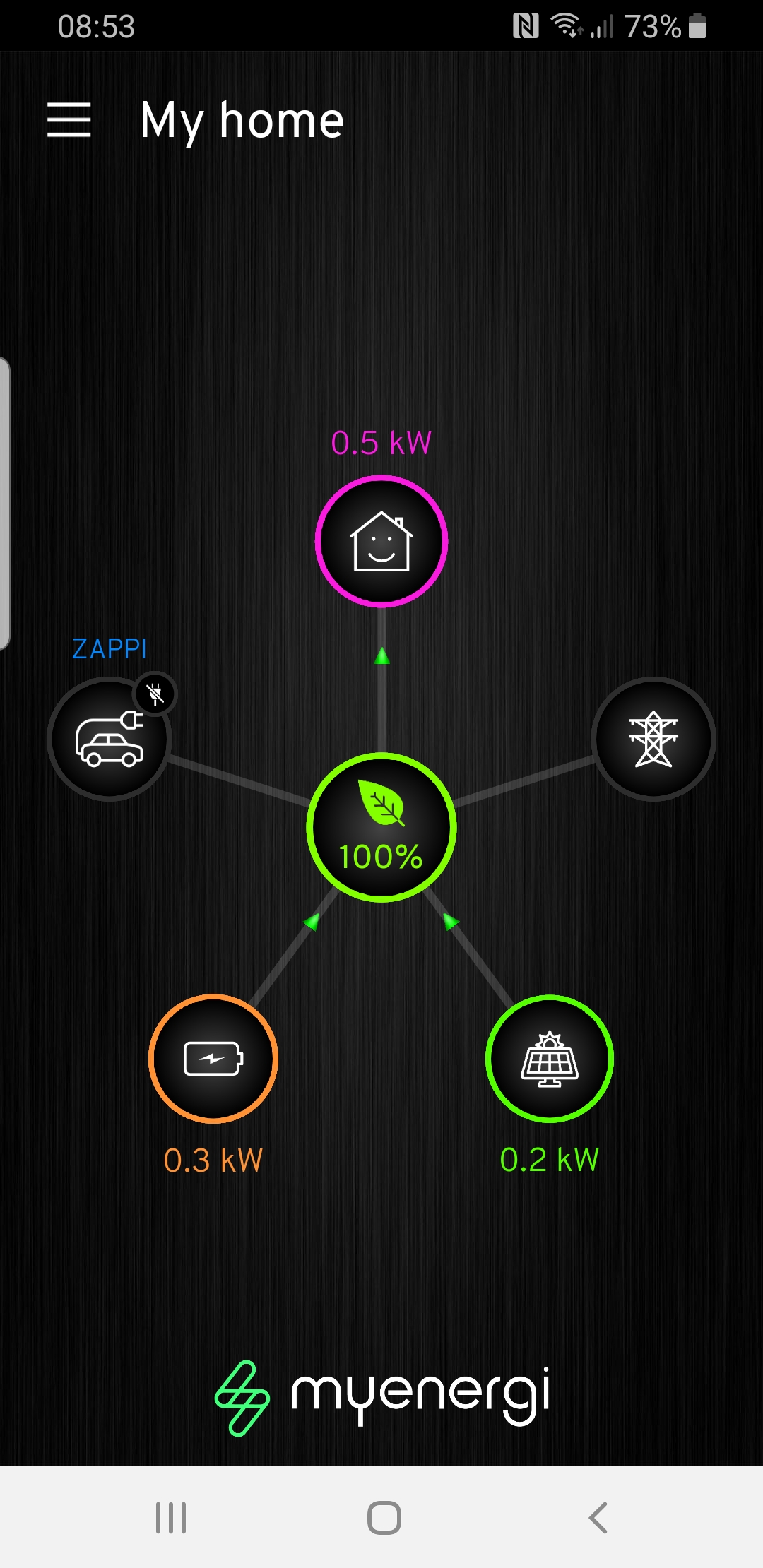
MyEnergi App
As well as the Zappi charger the App also shows my solar and battery flows
The Zappi as a Hub
One of the things MyEnergi have done really well is integrate a wireless hub into the Zappi. This means that if you have one of their other products such as the Eddi Solar hot water diverter, the Zappi hub can also control the heating of hot water with excess solar without running extra measurement cables. They also have a clever device called the Harvi that allows wireless connections of CTs without any cables at all. In practice I couldn’t make this work for my solar due to the distance, so I ended up wiring a physical connection. Luckily I had already run spare twisted pair cables for my solar CTs.
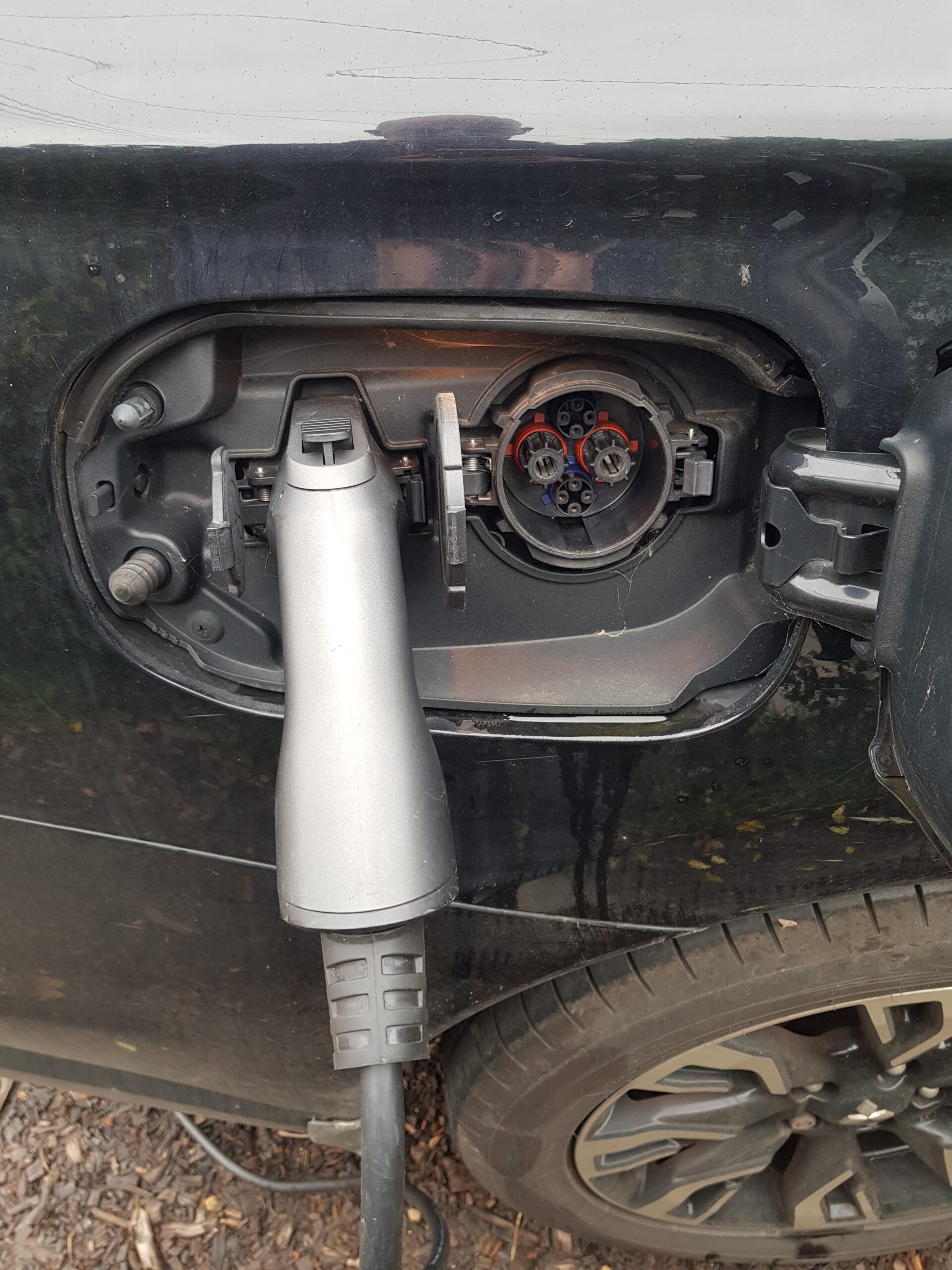
CHAmeDO DC bidirectional charging port on Outlander PHEV
CHAmeDO ports are not common on European cars.
What about Vehicle to Grid?
You may have seen news of trials of Vehicle to Grid (V2G) technology. The idea being as your car is sat in your driveway much of the time, why not use its battery capacity to supply and balance the grid? It’s a great idea, why install a house battery when you have a large battery with wheels attached parked in your drive much of the time?
Octopus have introduced a beta tariff called Octopus Power Pack.
So far it only supports three cars, two variants of the Nissan Leaf, and to my surprise the Outlander PHEV. This seems to be because they are Japanese cars and all have the DC rapid charge bidirectional CHAdeMO charging port in addition to the type 1/2. This charge port isn’t common on European cars.
There is also currently only one charger that supports this, the Wallbox Quasar 1 V2G charger. It comes in at £4000 which is a little too expensive for me, unless Octopus start to subsidise them. The Zappi installation is a quarter of this.
Nonetheless, it’s great that Octopus are rolling out this technology and i’m sure it will become common place in the near future.
Conclusions
As fantastic as the ability to charge my car from Solar power is, the reality is most of the time I find the ability to charge at night on a lower rate the main advantage of the Zappi charger. It’s only really in the summer months that I have enough excess solar to significantly charge the car. As a PHEV the Outlander has a relatively small battery compared with a fully electric vehicle, so if charging a full EV you’re unlikely to charge all of the battery on solar alone. This is partly because I also added a house battery and that takes priority over the car charging. Since closing our business we don’t use a car that much. It was however great to do local deliveries to farm shops on solar power with our PHEV.
Once in a while I need to reset the Zappi as it loses connection with the Zappi cloud, though this is usually after the house wifi has gone down or a power cut.
I’ve also had slight confusion as you can control the Zappi from the App, from a myEnergi website login, and from the buttons on the front. In practice I leave it always set the same – Eco+ mode. If I plug it in I know it will charge on excess solar, or at night via Intelligent Octopus. So despite the myriad of settings in a complex intelligent charger, for me it’s a leave it alone most of the time. I suspect this will be the same for most people once you’ve worked out a charging setup to match your daily routine.
I highly recommend the MyEnergi Zappi based on my personal experience of using one and the ethos and UK manufacture of MyEnergi.
Hope you find this useful.
If you’re interested in installing solar panels and a solar diverting charger like the Zappi please see our Community Solar Discount scheme.
Matthew


